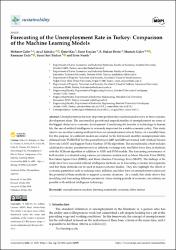| dc.contributor.author | Güler, Mehmet | |
| dc.contributor.author | Kabakçı, Ayşıl | |
| dc.contributor.author | Koç, Ömer | |
| dc.contributor.author | Eraslan, Ersin | |
| dc.contributor.author | Derin, K. Hakan | |
| dc.contributor.author | Güler, Mustafa | |
| dc.contributor.author | Ünlü, Ramazan | |
| dc.contributor.author | Türkan, Yusuf Sait | |
| dc.contributor.author | Namlı, Ersin | |
| dc.date.accessioned | 2024-08-20T11:35:45Z | |
| dc.date.available | 2024-08-20T11:35:45Z | |
| dc.date.issued | 2024 | en_US |
| dc.identifier.issn | 20711050 | |
| dc.identifier.uri | https://doi.org/10.3390/su16156509 | |
| dc.identifier.uri | https://hdl.handle.net/20.500.12573/2337 | |
| dc.description.abstract | Unemployment is the most important problem that countries need to solve in their economic development plans. The uncontrolled growth and unpredictability of unemployment are some of the biggest obstacles to economic development. Considering the benefits of technology to human life, the use of artificial intelligence is extremely important for a stable economic policy. This study aims to use machine learning methods to forecast unemployment rates in Turkey on a monthly basis. For this purpose, two different models are created. In the first model, monthly unemployment data obtained from TURKSTAT for the period between 2005 and 2023 are trained with Artificial Neural Networks (ANN) and Support Vector Machine (SVM) algorithms. The second model, which includes additional economic parameters such as inflation, exchange rate, and labor force data, is modeled with the XGBoost algorithm in addition to ANN and SVM models. The forecasting performance of both models is evaluated using various performance metrics such as Mean Absolute Error (MAE), Root Mean Square Error (RMSE), and Mean Absolute Percentage Error (MAPE). The findings of the study show how successful artificial intelligence methods are in forecasting economic developments and that these methods can be used in macroeconomic studies. They also highlight the effects of economic parameters such as exchange rates, inflation, and labor force on unemployment and reveal the potential of these methods to support economic decisions. As a result, this study shows that modeling and forecasting different parameter values during periods of economic uncertainty are possible with artificial intelligence technology. | en_US |
| dc.language.iso | eng | en_US |
| dc.publisher | MDPI | en_US |
| dc.relation.isversionof | 10.3390/su16156509 | en_US |
| dc.rights | info:eu-repo/semantics/openAccess | en_US |
| dc.subject | unemployment | en_US |
| dc.subject | machine learning | en_US |
| dc.subject | sustainable economy | en_US |
| dc.subject | labor market | en_US |
| dc.title | Forecasting of the Unemployment Rate in Turkey: Comparison of the Machine Learning Models | en_US |
| dc.type | article | en_US |
| dc.contributor.department | AGÜ, Mühendislik Fakültesi, Endüstri Mühendisliği Bölümü | en_US |
| dc.contributor.authorID | 0000-0002-1201-195X | en_US |
| dc.contributor.institutionauthor | Ünlü, Ramazan | |
| dc.identifier.volume | 16 | en_US |
| dc.identifier.issue | 15 | en_US |
| dc.identifier.startpage | 1 | en_US |
| dc.identifier.endpage | 17 | en_US |
| dc.relation.journal | Sustainability (Switzerland) | en_US |
| dc.relation.publicationcategory | Makale - Uluslararası Hakemli Dergi - Kurum Öğretim Elemanı | en_US |


















